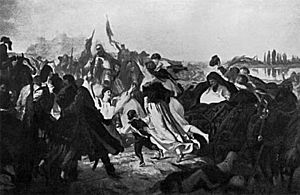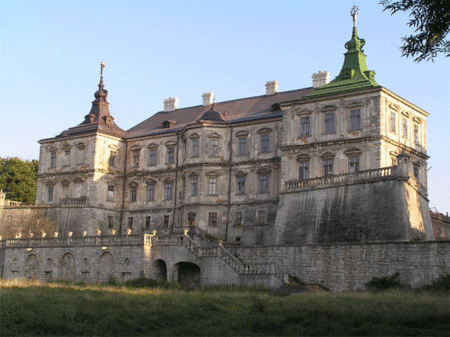Stanisław Koniecpolski facts for kids
Quick facts for kids
Hetman
Stanisław Koniecpolski |
|
|---|---|
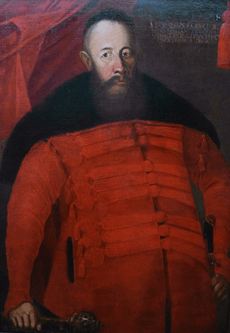
Stanisław Koniecpolski, by an anonymous painter, 17th century |
|
| Coat of arms | Pobóg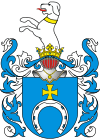 |
| Born | 1590/1594 unknown |
| Died | 11 March 1646 (aged 52–56) Brody, Polish–Lithuanian Commonwealth |
| Noble family | Koniecpolski |
| Spouse(s) | Katarzyna Żółkiewska (1615) Krystyna Lubomirska (1619) Zofia Opalińska (1646) |
| Issue | Aleksander Koniecpolski |
| Father | Aleksander Koniecpolski |
| Mother | Anna Sroczycka |
Stanisław Koniecpolski (born 1591, died March 11, 1646) was a famous Polish military leader. Many people consider him one of the most skilled commanders in the history of the Polish–Lithuanian Commonwealth. He was also a powerful noble, a royal official called a starosta (mayor), and a voivode (governor) of Sandomierz.
Koniecpolski spent most of his life fighting in wars. He fought against rebelling Cossacks and invading Tatars. In 1618, he became a Field Crown Hetman. This was a high military rank. Later, in 1632, he became the Grand Crown Hetman, the top military commander after the King.
He was captured by Ottoman forces in 1620 during the Battle of Cecora. After his release, he defeated the Tatars many times. He also stopped the Swedish army, led by Gustavus Adolphus, from taking over parts of Poland. This happened during the Polish–Swedish War (1626–29). His victory against the Tatars at the Battle of Ochmatów in 1644 made him famous around the world.
Contents
Early Life of Stanisław Koniecpolski
The exact details of Stanisław Koniecpolski's birth are not fully clear. He was likely born between 1590 and 1594. We do not know his exact birthplace. His father, Aleksander Koniecpolski, was a very rich noble. He was also the governor of Sieradz. His father strongly supported King Sigismund III.
Stanisław's mother, Anna Sroczycka, came from a wealthy family too. She brought many large estates in Podole into the Koniecpolski family. Stanisław had several brothers. One brother, Krzysztof, became a Grand Standard-Bearer. Another, Remigiusz, became a bishop.
Education and First Job
Even though Koniecpolski had a stutter, he got an important job at age 15. He became the starosta (mayor) of Wieluń. This happened thanks to his father's influence at the royal court. In 1603, he started studying at the Kraków Academy.
After a few years, his father sent him to the royal court. There, he could learn more practical skills. He probably stayed there for a year or two. He might have also traveled through Western Europe, spending time in France. Then he returned to his family's estates.
Military Career Begins: 1610–1626

Stanisław Koniecpolski chose a military career from a young age. In 1610, he joined the army with his brother Przedbór. They fought against Muscovy in the Dymitriads. He led 300 men to join the army at Smolensk.
On July 4, 1610, he fought in the Battle of Klushino. Then he joined the Siege of Smolensk. Sadly, his brother Przedbór died there in 1611. After returning home, Koniecpolski rejoined the army. He helped supply Polish forces stuck in the Moscow Kremlin.
Learning from a Master
In 1612, Koniecpolski joined the regular army in Ukraine. He served under Field Crown Hetman Stanisław Żółkiewski. Żółkiewski greatly influenced Koniecpolski's career. In 1614, Koniecpolski was tasked with stopping rebellious army units. He won the Battle of Rohatyn and captured the rebel leader.
In 1615, he married Żółkiewski's daughter, Katarzyna. Soon after, he received the rank of Crown Master of the Pantry. He gained more experience fighting Tatar groups in Ukraine. In 1616, Katarzyna died giving birth to their first son, Andrzej.
Fighting in Moldova and Against Tatars
In 1617, Koniecpolski fought in the Moldavian Magnate Wars. He faced a strong Turkish army. The conflict ended with a truce. He also helped reduce the number of Cossacks allowed in the army. He banned their raids on the Black Sea. These raids often made the Ottoman Empire angry.
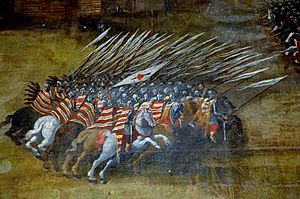
In 1618, King Sigismund III Vasa made Koniecpolski the Field Crown Hetman. This was a very important military position. Soon after, he was defeated by Tatars near Orynin. He barely survived the battle. In 1619, Koniecpolski married Krystyna Lubomirska. They had a son, Aleksander, the next year.
Captured by the Ottomans
In 1620, Koniecpolski and Żólkiewski led an army to Moldova. They wanted to protect an ally of the Commonwealth. Their army had over 7,000 soldiers. During the Battle of Cecora, their forces were defeated. Koniecpolski commanded the right side of the army.
During the retreat, the army fell apart. Żólkiewski was killed. Koniecpolski and many other nobles were captured. They were taken to the Castle of Seven Towers in Constantinople. They were held there for a long time. In 1623, a diplomatic mission paid for their freedom.
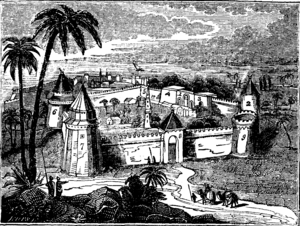
After his release, Koniecpolski was ordered to stop new Tatar attacks. In early 1624, he destroyed one Tatar army. Later that year, he defeated them again at the Battle of Martynów. He used a new strategy with light Cossack cavalry. His victory was celebrated. He was given money and made governor of Sandomierz.
Dealing with Cossack Rebellions
In 1625, the Zaporozhian Cossacks rebelled. Koniecpolski gathered a 12,000-strong army. He promised fair treatment to loyal Cossacks and death to rebels. He attacked the Cossacks near Kryłów. The battle was tough, but it ended in a truce.
The Treaty of Kurukove was signed. It set the Cossack army size and made them promise to stop raiding. Koniecpolski wanted harsh punishments for rebels. But he also believed Cossacks needed better treatment and pay. He also supported turning Cossacks into serfs. This made him very unpopular in Ukraine.
In early 1626, Tatars invaded again. Koniecpolski gathered 13,000 troops. He defeated the rear guard of the Tatar army. Later that year, he raised an army against another expected Tatar attack. He was helped by a skilled officer, Bohdan Khmelnytsky.
Fighting Gustavus Adolphus: 1626–1629
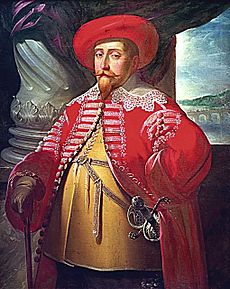
In 1626, a new threat came from the north. Swedish forces started the Polish–Swedish War. Gustavus Adolphus landed with a large army. He began taking control of Polish ports and cities. The major city of Gdańsk refused to surrender.
King Sigismund was defeated in a battle near Gniew. Koniecpolski was then sent to defend Royal Prussia. He quickly moved his forces to Prussia. He had 9,000 men against 20,000 Swedes. He used quick, mobile units to attack Swedish supply lines. This stopped the Swedish attack.
Turning the Tide of War
On April 2, 1627, Koniecpolski recaptured Puck. He also took Czarne. He forced the Swedish forces to surrender. Many mercenaries even switched sides. These defeats made the Swedes lose hope for a quick victory. The Elector of Brandenburg then supported the Commonwealth.
On May 17, Gustavus landed with 8,000 more soldiers. Koniecpolski surprised Gustavus near Danzig. Gustavus was wounded and had to retreat. Koniecpolski then tricked Gustavus. He made Gustavus chase a small Polish army. Meanwhile, Koniecpolski captured Gniew, his main target. Gustavus was very impressed by Koniecpolski's speed.
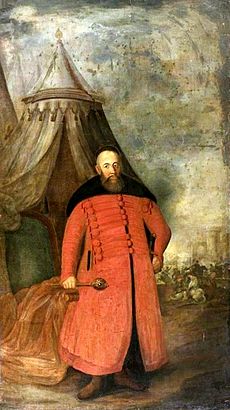
Near Tczew, Koniecpolski tried to stop the Swedish army. He had about 7,800 men, including elite hussar cavalry. The Swedes had 10,000 men. Koniecpolski decided not to attack directly. The Swedes attacked, but could not draw the Poles into their firing range. The battle ended when Gustavus Adolphus was wounded again.
Koniecpolski realized his army needed to change. He wanted to improve their infantry and artillery. The Swedes, in turn, learned cavalry tactics from the Poles. The 1627 campaign was good for the Commonwealth. They retook cities and weakened the Swedish army.
Final Battles and Truce
In 1628, Polish forces had little money. They had to fight defensively. Gustavus Adolphus captured more cities. Koniecpolski counterattacked using clever tactics. He used quick cavalry attacks and strong infantry fire. He also used guerrilla warfare and engineers to build defenses.
The final battle happened on June 27, 1629, near Trzciana. Koniecpolski attacked the Swedish rear guard and destroyed it. He also stopped a counterattack led by Gustavus Adolphus himself. Gustavus was wounded and barely escaped. The Swedes lost 1,200 men. Polish losses were very low.
Despite this victory, Poland did not gain much. A truce was signed that favored the Swedes. They could tax Polish trade on the Baltic Sea. They also kept control of many cities. Koniecpolski had to leave the negotiations. He was called back to Ukraine to fight Tatars.
Grand Crown Hetman: 1630–1637
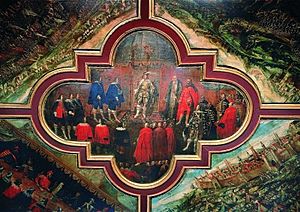
In 1630, a Cossack leader started the "Fedorovych Uprising". Koniecpolski besieged a fortress. He could not break its walls. But the Cossacks agreed to talk. The Treaty of Pereyaslav was signed. It gave amnesty to the rebels.
Koniecpolski wanted to punish the rebels harshly. But he also thought Cossacks needed better treatment. He supported increasing their army size and paying them regularly. However, he also wanted to turn Cossacks into serfs. This made him very unpopular in Ukraine.
In 1632, King Sigismund III Vasa made Koniecpolski the Grand Crown Hetman. This was the highest military position. The King had waited 12 years to give him this job. He might have feared Koniecpolski would become too powerful. After the King's death, Koniecpolski helped elect Władysław IV Vasa as the new king.
A year later, King Władysław IV made Koniecpolski the Castellan of Kraków. This was a very important government job. Koniecpolski became a key advisor to the new king. He often encouraged the king to focus on fighting the Tatars. He also supported the king's military changes.
In 1633, Koniecpolski stopped Turkish attacks on the Commonwealth. He defeated their forces. On October 22, he pushed back a large Ottoman army. His own forces were much smaller. These defeats made the Turks sign a new treaty in 1634. This ended the Ottoman–Commonwealth War.
In 1635, another Cossack uprising happened. Cossacks captured and destroyed a Polish fortress. Koniecpolski led an army to retake it. He punished the rebels. The rebel leader was captured and executed. Later that year, Koniecpolski prepared for another war with Sweden. But a treaty made it unnecessary.
Koniecpolski knew the Commonwealth's army needed to be modern. He worked with King Władysław IV on this. They hired experienced soldiers from Western Europe. They also improved artillery. Koniecpolski built weapons factories and supported engineers. He also helped map Ukraine and Crimea. He even supported plans for a Polish navy.
Later Years and Final Victory: 1637–1645

After 1637, Koniecpolski's health declined. He relied on a younger hetman, Mikołaj Potocki. Potocki successfully stopped Cossack uprisings in 1637 and 1638. He also stopped a Tatar uprising in 1639. Koniecpolski also protected a famous outlaw, Samuel Łaszcz, seeing him as a good commander.
One of Koniecpolski's greatest victories happened in 1644. He led a winter campaign against the Tatars. He had a large army of about 19,000 soldiers. He crushed the Tatar forces near Ochmatów on January 30, 1644. Many Tatars drowned when ice broke.
The Battle of Ochmatów was a huge victory. It brought Koniecpolski international fame. He had predicted the Tatar attack. He destroyed their forces before they could use their usual tactics.
This victory made King Władysław IV think about attacking the Turks. Koniecpolski supported a small war against the Tatars. But he thought a war against the entire Ottoman Empire was unrealistic. He suggested forming an alliance with Moscow for such a campaign. King Władysław IV still wanted a crusade against Turkey. But it had little support and failed.
On June 15, 1645, Koniecpolski's wife, Krystyna, died. He remarried soon after. He married 16-year-old Zofia Opalińska on January 16, 1646. But the marriage was short. Koniecpolski died in Brody on March 11, 1646. His funeral was held in Brody on April 30, 1646.
Wealth and Influence
Stanisław Koniecpolski became very rich during his life. Most of his wealth was in Ukraine. He became like an unofficial ruler of Ukraine. Some foreigners even called him "viceroy of Ukraine." King Władysław IV trusted him with most decisions about this region.
As Grand Crown Hetman, he controlled a large part of the army. He had his own private army. He also had a spy network that reached from Moscow to the Ottoman Empire. He inherited a few villages from his father. When he died, he owned over 300 settlements. These included many towns. His yearly income was over 500,000 złoty.
He owned a huge amount of land and serfs in western Ukraine. He invested a lot of his money in developing his Ukrainian estates. He helped settle areas that were not very populated. He founded and supported many towns and cities. The town of Brody grew a lot because of his investments. It became an important trading center.
Koniecpolski built strong defenses for Brody in 1633. He also set up workshops there. These workshops made Persian-style fabrics, carpets, and rugs. He also built a fortified palace in Pidhirtsi with beautiful Italian gardens. Like many rich nobles, Koniecpolski supported artists. He also founded many churches. He wanted to make Brody's school into an academy. He also helped build the Koniecpolski Palace in Warsaw.
Koniecpolski was known as a polite and educated man. He attended all the parliament sessions he could. He rarely spoke in public because of his stutter. He was highly respected and popular among other nobles.
See also
 In Spanish: Estanislao Koniecpolski para niños
In Spanish: Estanislao Koniecpolski para niños



